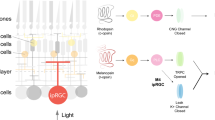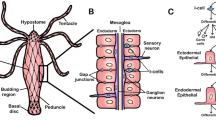Synopsis
Catecholamines were demonstrated histochemically in the superior cervical ganglion of albino rats aged o (newborn), 3, 6, 12, 24 or 90 days (adult). After freezing in propane at −190°C, the ganglia were driedin vacuo at −50°C for a week and embedded in epoxy resin. Fluorescence microscopy was carried out with maximum excitation at about 400 nm and emission above 460 nm, avoiding fading due to over-exposure to u.v. light. Most sympathicoblasts in the ganglia of newborn rats exhibited a weak, blue fluorescence which was evenly distributed throughout the cytoplasm. Most cells were still weakly fluorescent in rats 3 and 6 days old, although the number of more intensely fluorescent cells increased with age. The size and the fluorescence intensity of the nerve cells increased with development until the adult stage. The cytoplasmic fluorescent granular aggregates were first seen in the peripheral cytoplasm of nerve cells of 12-day-old rats, and in the ganglia of 24-day-old rats the peripheral granules showed the adult picture. Fluorescent processes were seen to emerge from nerve cells of 3-day-old rats, but fluorescent nerve fibres were first seen between the nerve cell bodies in the ganglia of 6-day-old rats, and intensely fluorescent granular formations appeared in the intercellular nerve cell processes in 24-day-old rats. Small intensely fluorescent cells were already numerous at birth and at all stages of development were easily discriminated from sympathicoblasts and the developing nerve cells by virtue of their much smaller size.
It is concluded that the nerve cell perikaryon matures when rats are 3 weeks old, which coincides with the maturation of the peripheral nerve net in peripheral target organs. This maturation is characterized by the appearance of a granular pool of catecholamines in the perikaryon and the terminal nerve fibres, corresponding to clusters of small granular vesicles at the ultrastructural level.
Similar content being viewed by others
References
Björklund, A., Enemar, A. &Falck, B. (1968). Monoamines in the hypothalamo-hypophyseal system of the mouse with special reference to the ontogenetic aspects.Z. Zellforsch. 89, 590–607.
Champlain, J. De, Malmfors, T., Olson, L. &Sachs, C. (1970). Ontogenesis of peripheral adrenergic neurons in the rat: pre- and postnatal observations.Acta physiol. scand. 80, 276–88.
Elfvin, L. G. (1971). Ultrastructural studies on the synaptology of the inferior mesenteric ganglion of the cat.J. ultrastruct. Res. 37, 411–48.
Enemar, A., Falck, B. &Håkanson, R. (1965). Observations on the appearance of norepinephrine in the sympathetic nervous system of the chick embryo.Devel. Biol. 11, 268–83.
Eränkö, O. (1955). Distribution of fluorescing islets, adrenaline and noradrenaline in the adrenal medulla of the hamster.Acta endocrinol. 18, 174–9.
Eränkö, O. (1967a). Histochemistry of nervous tissues: catecholamines and cholinesterases.Ann. Rev. Pharmacol. 7, 203–22.
Eränkö, O. (1967b). The practical histochemical demonstration of catecholamines by formaldehyde-induced fluorescence.Jl. R. microsc. Soc. 87, 259–76.
Eränkö, L. (1972). Light and electron microscopic histochemical evidence of granular and nongranular storage of catecholamines in the sympathetic ganglion of the rat.Histochem. J. 4, 213–24.
Eränkö, L. &Eränkö, O. (1972). Effect of hydrocortisone on histochemically demonstrable catecholamines in the sympathetic ganglia and extra-adrenal chromaffin tissue of the rat.Acta physiol. scand. 84, 125–33.
Eränkö, O. &Eränkö, L. (1971). Small, intensely fluorescent, granule-containing cells in the sympathetic ganglion of the rat.Progr. Brain Res. 34, 39–52.
Eränkö, O. &Härkönen, M. (1963). Histochemical demonstration of fluorogenic amines in the cytoplasm of sympathetic ganglion cells of the rat.Acta physiol. scand. 58, 285–86.
Gabella, G. & Costa, M. (1968). La distribuzione delle fibre adrenergiche nell'intestino tenue di cavia neonata. Scr. med. in onore del Prof. G. Dellepiane.Accad. med. 453–5.
Hervonen, A. (1971). Development of catecholamine-storing cells in human fetal paraganglia and adrenal medulla.Acta physiol. scand. 63, Suppl. 368, 1–94.
Hökfelt, T. (1969). Distribution of noradrenaline storing particles in peripheral adrenergic neurons as revealed by electron microscopy.Acta physiol. scand. 76, 427–40.
Jacobowitz, D. (1970). Catecholamine fluorescence studies of adrenergic neurons and chromaffin cells in sympathetic ganglia.Fedn Proc. 29, 1929–44.
Kanerva, L. (1971). The postnatal development of monoamines and cholinesterases in the paracervical ganglion of the rat uterus.Progr. Brain Res. 34, 433–44.
Machado, C. R. S., Wragg, L. E. &Machado, A. B. M. (1968). A histochemical study of sympathetic innervation and 5-hydroxytryptamine in the developing pineal body of the rat.Brain Res. 8, 310–18.
Norberg, K. A. &Hamberger, B. (1964). The sympathetic adrenergic neuron.Acta physiol. scand. 63, Suppl. 238, 1–42.
Olson, L. (1967). Outgrowth of sympathetic adrenergic neurons in mice treated with a Nerve-Growth-Factor (NGF).Z. Zellforsch. 81, 155–73.
Ploem, J. S. (1971). The microscopic differentiation of the colour of formaldehyde-induced fluorescence.Progr. Brain Res. 34, 27–38.
Read, J. B. &Burnstock, G. (1969). A method for the localization of adrenergic nerves during early development.Histochemie 20, 197–200.
Schiebler, T. H. &Heene, R. (1968). Nachweis von Katecholaminen in Rattenherzen während der Entwicklung.Histochemie 14, 328–34.
Schiebler, T. H. &Winckler, J. (1971). On the vegetative cardiac innervation.Progr. Brain Res. 34, 405–14.
Van Orden, L. S. III, Burke, J. P., Geyer, M. &Lodoen, F. V. (1970). Localization of depletion-sensitive and depletion-resistant norepinephrine storage sites in autonomic ganglia.J. Pharmacol. exp. Ther. 174, 56–71.
Yamauchi, A. &Burnstock, G. (1969). Post-natal development of the innervation of the mouse vas deferens. A fine structural study.J. Anat. 104, 17–32.
Author information
Authors and Affiliations
Additional information
This study was carried out in the University of Helsinki during the academic year 1970–1. The manuscript was completed in the University of Melbourne, where the author was a Sunshine Foundation and Rowden White Overseas Research Fellow from September 1971 to August 1972.
Rights and permissions
About this article
Cite this article
Eränkö, L. Postnatal development of histochemically demonstrable catecholamines in the superior cervical ganglion of the rat. Histochem J 4, 225–236 (1972). https://doi.org/10.1007/BF01890994
Received:
Issue Date:
DOI: https://doi.org/10.1007/BF01890994




